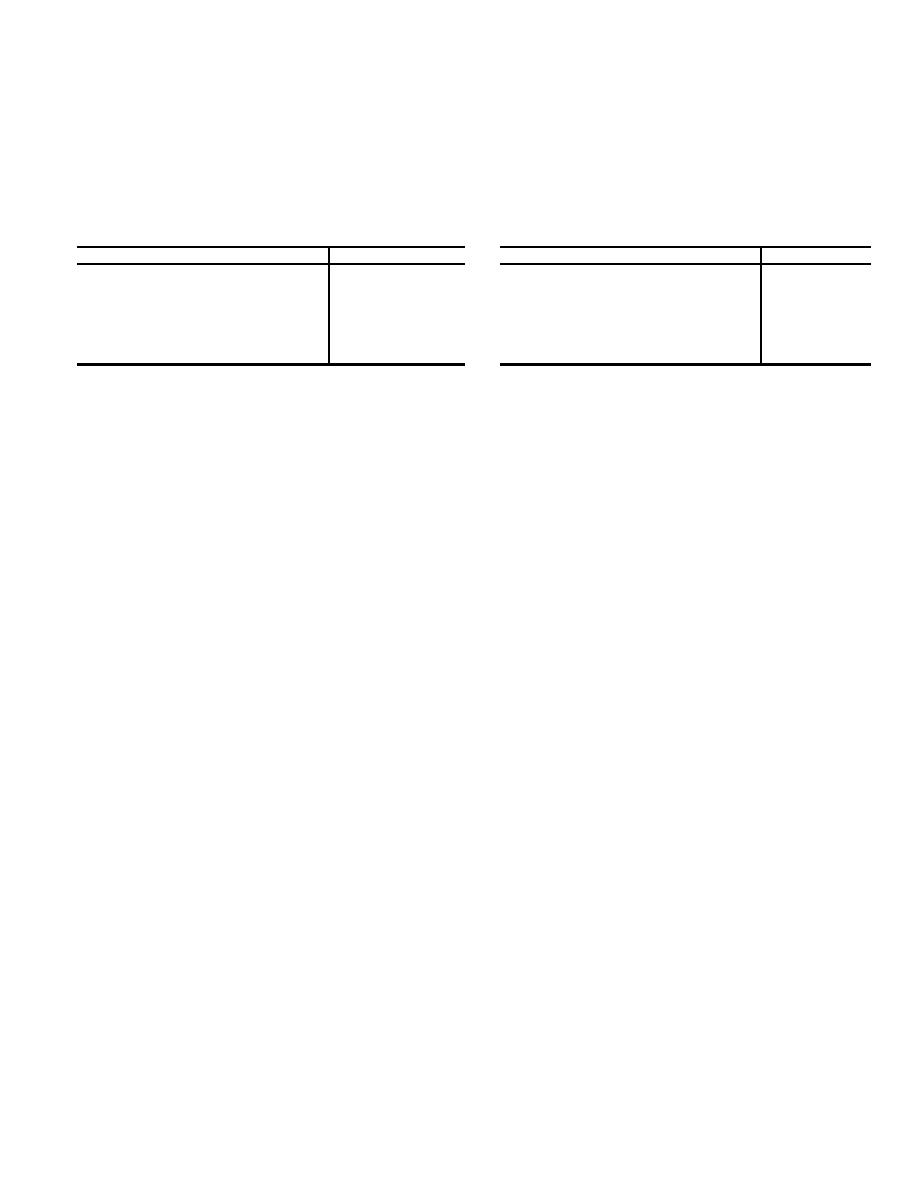
TM 11-6625-1668-12
reading indicates the presence of spacing distortion. Both early and late readings indicate the presence of
fortuitous distortion. To quickly determine the peak distortion without regard to early or late measurements, the
DISTORTION switch is set to TOTAL. The amount of speed distortion is determined by measuring the
distortion on successive transitions. The distortion measurement increases on each successive transition. A
faster incoming signal will introduce marking bias and a slower incoming signal will introduce spacing bias.
(4) Typical operation, DIST. For the purpose of this example assume the following analyzer input
signal characteristics; 60 volts polar at 20 ma, 150 bauds, positive mark, 1:1 reversals, 25 percent distortion
(marking bias). Initial analyzer control settings are listed below.
Control
Position
Control
Position
POWER switch..................................
OFF
INPUT switch .......................................
20P
MARK POLARITY switch ...................
+
TRANSITION switch ............................
ALL
RESET switch....................................
OFF
DISTORTION switch ............................
AVERAGE
BIAS S/M
DISPLAY MODE switch .....................
DIST (%)
BAUD RATE switch..............................
150
CODE LEVEL switch .........................
5
NOTE
The position of unmentioned controls will not affect operation in this mode.
(a)
Connect the external data signal to the analyzer SERIES input jack.
(b)
Set the POWER switch to ON.
Reset the nixie display and read 25 percent average marking bias distortion 2 percent.
(c)
(d)
Set the TRANSITION switch to 1 and read 25 percent marking bias on the first intelligence bit
2 percent.
(e) Sequentially select transitions 2, 3, 4, 5 and read the amount of bias distortion on each
intelligence bit. (Odd numbered transitions are distorted, even numbered transitions do not appear on the data
signal.)
(f) Set the TRANSITION switch to ALL, the DISTORTION switch to AVERAGE END M/S, reset the
nixie display and read 0 average end distortion 2 percent.
(g) Set the DISTORTION switch to PEAK TOTAL, reset the nixie display and measure 25 percent
total peak distortion 2%.
(h) Set the DISTORTION switch to EARLY, reset the nixie and read 25 percent early peak
distortion 2 percent.
(i) Set the DISTORTION switch to LATE, reset the nixie display and read 0 percent late peak
distortion- 2 percent.
(5) ERROR RATE (Hits/10n). The analyzer is used to measure error rate on a 2047 bit pseudo-random
test message. The rate is displayed as errors per thousand or million bit times. The message is generated
within the analyzer and is available at the rear panel connector 2A3J3. The data output is supplied at 6 volts
at pin 8, and its return at pin 24. To measure error rate two analyzers are required, one for transmitting the
message and one for receiving and analysis. For normal operation, the transmitting analyzer controls are set
as follows: POWER to ON, DISPLAY MODE to TEST MODE, CODE LEVEL to SYNC, RESET to OFF and
BAUD RATE to the desired operating speed. The receiving analyzer controls are set as follows: POWER to
3
6
ON, DISPLAY MODE to ERROR RATE 10 or 10 , ERROR DEFINER to the maximum permissable distortion
percentage. RESET to OFF and BAUD RATE to the same speed as the transmitting analyzer. The input
connection is made to either the SERIES or BRIDGING input jacks on the receive analyzer front panel. The
INPUT switch is set to the position that corresponds with the input signal level. The positions of the
unmentioned controls will not affect operation in this mode.
The correct position of the MARK POLARITY switch is determined by setting the RESET switch to MAN and
releasing to the OFF position. If the SPACE/START lamp illuminates the mark polarity is correct. If this lamp
does not illuminate, set the MARK POLARITY switch to the opposite polarity and operate the RESET switch as
previously described. The SPACE/START lamp will illuminate when the internal and external pseudo-random
test messages are synchronized, and remain illuminated until the measurement period is completed.
When synchronization occurs the analyzer begins to count errors and will stop counting only when the period of
measurement for a thousand or million bit times has elapsed. At this point the MARK-STOP lamp illuminates
and the number displayed on the nixie readout indicates error rate. This number (error rate) remains displayed
3-16



 Previous Page
Previous Page
